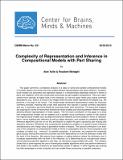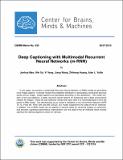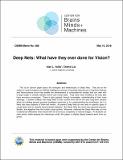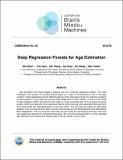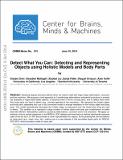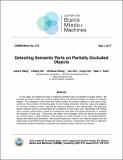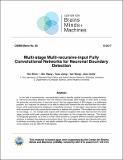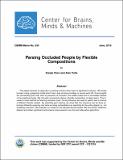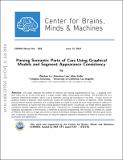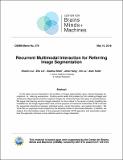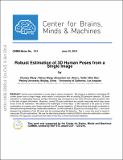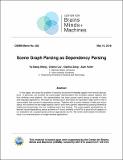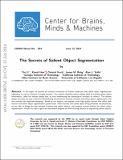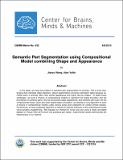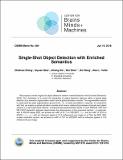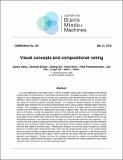Browsing CBMM Memo Series by Author "Yuille, Alan L."
Now showing items 1-18 of 18
-
Complexity of Representation and Inference in Compositional Models with Part Sharing
Yuille, Alan L.; Mottaghi, Roozbeh (Center for Brains, Minds and Machines (CBMM), arXiv, 2015-05-05)This paper performs a complexity analysis of a class of serial and parallel compositional models of multiple objects and shows that they enable efficient representation and rapid inference. Compositional models are generative ... -
Deep Captioning with Multimodal Recurrent Neural Networks (m-RNN)
Mao, Junhua; Xu, Wei; Yang, Yi; Wang, Jiang; Huang, Zhiheng; e.a. (Center for Brains, Minds and Machines (CBMM), arXiv, 2015-05-07)In this paper, we present a multimodal Recurrent Neural Network (m-RNN) model for generating novel image captions. It directly models the probability distribution of generating a word given previous words and an image. ... -
Deep Nets: What have they ever done for Vision?
Yuille, Alan L.; Liu, Chenxi (Center for Brains, Minds and Machines (CBMM), 2018-05-10)This is an opinion paper about the strengths and weaknesses of Deep Nets. They are at the center of recent progress on Artificial Intelligence and are of growing importance in Cognitive Science and Neuroscience since they ... -
Deep Regression Forests for Age Estimation
Shen, Wei; Guo, Yilu; Wang, Yan; Zhao, Kai; Wang, Bo; e.a. (Center for Brains, Minds and Machines (CBMM), 2018-06-01)Age estimation from facial images is typically cast as a nonlinear regression problem. The main challenge of this problem is the facial feature space w.r.t. ages is inhomogeneous, due to the large variation in facial ... -
DeepVoting: A Robust and Explainable Deep Network for Semantic Part Detection under Partial Occlusion
Zhang, Zhishuai; Xie, Cihang; Wang, Jianyu; Xie, Lingxi; Yuille, Alan L. (Center for Brains, Minds and Machines (CBMM), 2018-06-19)In this paper, we study the task of detecting semantic parts of an object, e.g., a wheel of a car, under partial occlusion. We propose that all models should be trained without seeing occlusions while being able to transfer ... -
Detect What You Can: Detecting and Representing Objects using Holistic Models and Body Parts
Chen, Xianjie; Mottaghi, Roozbeh; Liu, Xiaobai; Fidler, Sanja; Urtasun, Raquel; e.a. (Center for Brains, Minds and Machines (CBMM), arXiv, 2014-06-10)Detecting objects becomes difficult when we need to deal with large shape deformation, occlusion and low resolution. We propose a novel approach to i) handle large deformations and partial occlusions in animals (as examples ... -
Detecting Semantic Parts on Partially Occluded Objects
Wang, Jianyu; Xe, Cihang; Zhang, Zhishuai; Zhu, Jun; Xie, Lingxi; e.a. (Center for Brains, Minds and Machines (CBMM), 2017-09-04)In this paper, we address the task of detecting semantic parts on partially occluded objects. We consider a scenario where the model is trained using non-occluded images but tested on occluded images. The motivation is ... -
Human-Machine CRFs for Identifying Bottlenecks in Holistic Scene Understanding
Mottaghi, Roozbeh; Fidler, Sanja; Yuille, Alan L.; Urtasun, Raquel; Parikh, Devi (Center for Brains, Minds and Machines (CBMM), arXiv, 2014-06-15)Recent trends in image understanding have pushed for holistic scene understanding models that jointly reason about various tasks such as object detection, scene recognition, shape analysis, contextual reasoning, and local ... -
Multi-stage Multi-recursive-input Fully Convolutional Networks for Neuronal Boundary Detection
Shen, Wei; Wang, Bin; Jiang, Yuan; Wang, Yan; Yuille, Alan L. (Center for Brains, Minds and Machines (CBMM), 2017-10-01)In the field of connectomics, neuroscientists seek to identify cortical connectivity comprehensively. Neuronal boundary detection from the Electron Microscopy (EM) images is often done to assist the automatic reconstruction ... -
Parsing Occluded People by Flexible Compositions
Chen, Xianjie; Yuille, Alan L. (Center for Brains, Minds and Machines (CBMM), arXiv, 2015-06-01)This paper presents an approach to parsing humans when there is significant occlusion. We model humans using a graphical model which has a tree structure building on recent work [32, 6] and exploit the connectivity prior ... -
Parsing Semantic Parts of Cars Using Graphical Models and Segment Appearance Consistency
Lu, Wenhao; Lian, Xiaochen; Yuille, Alan L. (Center for Brains, Minds and Machines (CBMM), arXiv, 2014-06-13)This paper addresses the problem of semantic part parsing (segmentation) of cars, i.e.assigning every pixel within the car to one of the parts (e.g.body, window, lights, license plates and wheels). We formulate this as a ... -
Recurrent Multimodal Interaction for Referring Image Segmentation
Liu, Chenxi; Lin, Zhe; Shen, Xiaohui; Yang, Jimei; Lu, Xin; e.a. (Center for Brains, Minds and Machines (CBMM), 2018-05-10)In this paper we are interested in the problem of image segmentation given natural language descriptions, i.e. referring expressions. Existing works tackle this problem by first modeling images and sentences independently ... -
Robust Estimation of 3D Human Poses from a Single Image
Wang, Chunyu; Wang, Yizhou; Lin, Zhouchen; Yuille, Alan L.; Gao, Wen (Center for Brains, Minds and Machines (CBMM), arXiv, 2014-06-10)Human pose estimation is a key step to action recognition. We propose a method of estimating 3D human poses from a single image, which works in conjunction with an existing 2D pose/joint detector. 3D pose estimation is ... -
Scene Graph Parsing as Dependency Parsing
Wang, Yu-Siang; Liu, Chenxi; Zeng, Xiaohui; Yuille, Alan L. (Center for Brains, Minds and Machines (CBMM), 2018-05-10)In this paper, we study the problem of parsing structured knowledge graphs from textual descrip- tions. In particular, we consider the scene graph representation that considers objects together with their attributes and ... -
The Secrets of Salient Object Segmentation
Li, Yin; Hou, Xiaodi; Koch, Christof; Rehg, James M.; Yuille, Alan L. (Center for Brains, Minds and Machines (CBMM), arXiv, 2014-06-13)In this paper we provide an extensive evaluation of fixation prediction and salient object segmentation algorithms as well as statistics of major datasets. Our analysis identifies serious design flaws of existing salient ... -
Semantic Part Segmentation using Compositional Model combining Shape and Appearance
Wang, Jianyu; Yuille, Alan L. (Center for Brains, Minds and Machines (CBMM), arXiv, 2015-06-08)In this paper, we study the problem of semantic part segmentation for animals. This is more challenging than standard object detection, object segmentation and pose estimation tasks because semantic parts of animals often ... -
Single-Shot Object Detection with Enriched Semantics
Zhang, Zhishuai; Qiao, Siyuan; Xie, Cihang; Shen, Wei; Wang, Bo; e.a. (Center for Brains, Minds and Machines (CBMM), 2018-06-19)We propose a novel single shot object detection network named Detection with Enriched Semantics (DES). Our motivation is to enrich the semantics of object detection features within a typical deep detector, by a semantic ... -
Visual concepts and compositional voting
Wang, Jianyu; Zhang, Zhishuai; Xie, Cihang; Zhou, Yuyin; Premachandran, Vittal; e.a. (Center for Brains, Minds and Machines (CBMM), 2018-03-27)It is very attractive to formulate vision in terms of pattern theory [26], where patterns are defined hierarchically by compositions of elementary building blocks. But applying pattern theory to real world images is very ...

